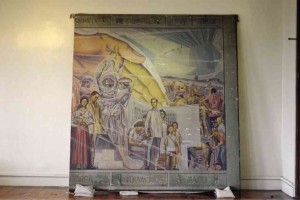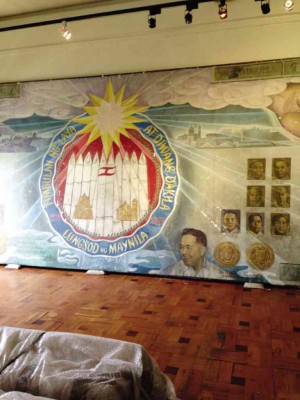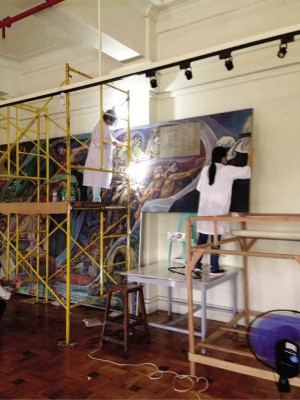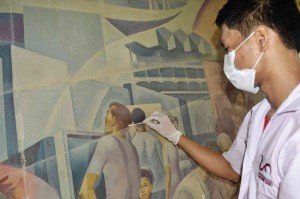
The process of conserving a painting is painstaking and slow; it is work requiring the patience of a stoic.
Nor is it a procedure always done in the comfort of a laboratory. Many times conservators work in situ, standing on scaffoldings to work on a painting or even lying flat on elevated platforms beneath high ceilings just to conserve a work of art.
The job is too technical to be carried out by an aficionado or even a painter with a Fine Arts degree. Therefore, the first and foremost criterion for the job is that it must be undertaken by a qualified, experienced conservator.
Thankfully, a small, overworked band of conservators exists in the Philippines. And to assure a next generation of conservators, National Museum conservators regularly tutor young apprentices who gain experience by participating in conservation activities.
Among the most notable paintings conserved by the National Museum is the “El Asesinato del Gobernador Bustamante” (The Assassination of Governor Bustamante), by Félix Resurrección Hidalgo (1855-1913), whose history and conservation procedure are detailed in the forthcoming inaugural issue of the Treasures of Philippine Art Series of publications on history of art and conservation.
Landmark project

The painting is “a landmark for many reasons,” writes museum director Jeremy Barns, and “as a National Treasure, for being one of the most ambitious conservation and restoration projects carried out with great success by the National Museum’s experts.”
Essays on the life and times of the painter by Alfredo Roces, and in-depth art historical studies of the painting by Pearlie Baluyut provide the background that places the Hidalgo work as deserving of its National Treasure position.
Before a painting is hung at any gallery of the National Museum, it goes through an exhaustive process of documentation and conservation, which is recounted in detail in an account written for the publication by National Museum conservators Orlando Albiñon, Roberto Balarbar, Willie Estonato and Raymundo Esguerra. Missy Reyes and Maita Reyes provided technical assistance for the conservation.
The conservation procedure started with careful assessment of the painting at the residence of National Artist for Architecture Leandro Locsin, whose philanthropy made it possible for the painting to be at the National Museum.
Described in the publication is the conservation process, starting with an assessment of its condition, which led to setting a treatment procedure to correct deterioration of the canvas; deterioration and some cracking in the paint itself and its protective varnish cover; and finally stains caused by dirt, acidity, aging and oxidation.
Thorough photographic documentation of the work was done, dividing the painting into quadrants to achieve more precision.
Documentation

Documentation provides the background reference that guides most of the conservation work.
For the Hidalgo painting, different types of cleaning solvents were tested to determine which were most compatible before mechanical and chemical cleaning was undertaken, a process that preceded the actual conservation of the paint itself, repair and strengthening of the canvas on which the paint was applied, and finally, mounting the painting on a new wooden stretcher.
The process is not as simple as it sounds. Actually, it is so complex and exacting that it requires a team of skilled chemists, lab technicians, textile and paint restorers, photographers and carpenters.
Watching an old painting shed the ravages of age to come to a new life is a fascinating process.
The Hidalgo work was conserved in 2007-’08, but painting conservation is a continual process at the National Museum.
In the process of conservation at the moment is “Filipino Struggles through History,” a 10-panel work that National Artist Carlos “Botong” Francisco (1912-1969) completed in 1964.

In February 2013, the City of Manila authorized the transfer of the massive work from Bulwagang Gat Antonio Villegas at Manila City Hall to the National Museum. The conservation work continues.
The project is totally funded by Tieza in partnership with the City of Manila, with the National Museum contributing the space for documentation, analysis, research and training.
Original space

Laid out in one of the empty galleries of the museum are the Botong panels that were removed from the City Hall by trained conservators.
Completed is the photographic-documentation process that made it possible to see the existing condition of each of the 10 panels through images magnified to 300 percent of the actual size.
The conservation procedure to be followed is similar to that of the Hidalgo painting, where each panel is relaxed, mechanically cleaned, its residues (dust, cobwebs) are removed; strengthening of the edges of each panel and stabilizing the seams of the canvas; re-stretching the canvas; and followed by analysis of the paint; repair of damage caused by wear and tear; and retouching of missing painted areas.
Being considered by the National Museum is the construction of a new gallery in the premises that will be the same size and scale of Bulwagang Gat Antonio Villegas to replicate the original space so that museum viewers can see the restored paintings in the same perspective as the artwork was conceived by the artist.
Before a work of art is hung in a gallery at the National Museum, it goes through the rigors of investigation, documentation and, if needed, conservation. Although the process is rarely seen by museum visitors, it is a process that makes each work of art more meaningful.
Send feedback to [email protected]













































